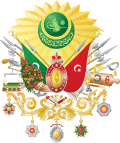| Year | Date | Event |
|---|
| 1512 | April 24 | Selim I, the Inflexible ascension to throne. |
| 1514 | | Battle of Chaldiran; Selim I defeats Ismail I of the Safavids; East Anatolia under Ottoman control for the first time. |
| 1516 | | Battle of Marj Dabiq; Selim I defeats Al-Ashraf Qansuh al-Ghawri of Mamluk Sultanate of Egypt. Syria and Palestine under Ottoman rule. |
| 1517 | | Battle of Ridaniya; Selim I defeats Tuman bay II of Mamluk Sultanate of Egypt. Egypt under Ottoman rule. |
| 1517 | | Piri Reis; presented the first world map of the Selim I. |
| 1519 | | Hayreddin Barbarossa, ruler of much of Algeria, agrees to become a provincial governor under the Ottomans. |
| 1519 | | Jelali revolts. |
| 1520 | | The reign of Suleiman the Magnificent (Suleiman I) begins. |
| 1521 | | Suleiman I conquers Belgrade. |
| 1522 | | Suleiman I captures Rhodes. |
| 1526 | | Battle of Mohács. Suleiman I defeats Louis II of Hungary and Bohemia. |
| 1529 | | Suleiman I besieges Vienna. |
| 1532 | | Suleiman I besieges Közseg. |
| 1534-6 | | Suleiman I leads the Two Iraqs campaign against the Safavids, annexing Baghdad. |
| 1536 | | Pargalı Ibrahim Pasha was executed. |
| 1537 | | Suleiman I besieges Korfu. |
| 1538 | | The Holy League navy is defeated in the Battle of Preveza. |
| 1541 | | Conquest of Buda and establishment of Ottoman rule over Hungary. |
| 1543 | | Suleiman I besieges Esztergom. |
| 1548 | | Campaign to Iran. |
| 1551 | | Siege of Tripoli (1551). Tripoli is taken over. |
| 1552 | August | Capture of Muscat. Muscat in the management of the Portuguese Empire, Seized by the Ottomans. |
| 1553 | October 6 | Execution of Şehzade Mustafa, the crown prince during the 12th campaign of Suleyman. |
| 1555 | | Peace of Amasya signed with the Safavid Empire. Western Armenia (Eastern Anatolia), western Georgia (incl. western Samtskhe), and western Kurdistan fall in Ottoman hands. The latter also gained control over most of Mesopotamia (Iraq). Eastern Armenia, Eastern Georgia (incl. eastern Samtskhe), Dagestan, and Shirvan (present-day Azerbaijan Republic) remain under Safavid rule. |
| 1560 | | Battle of Djerba |
| 1565 | | Failed siege of Malta. |
| 1565 | December | The Ottoman-Macedonian wars begin with the commencement of the Mariovo and Prilep rebellion. The Macedonian revolutionaries storm through the town of Prilep causing a conflict, the Ottoman janissaries later suppress the revolt. |
| 1566 | September 6 | The reign of Suleiman the Magnificent (Suleiman I) ends. Siege of Szigetvár. Selim II accession to throne. |
| 1568 | | The great fire of Istanbul Burns. |
| 1570-73 | | Ottoman–Venetian War (1570–73). Conquest of Cyprus. |
| 1571 | | Battle of Lepanto. The Holy League defeated the Ottomans. |
| 1571 | | Fire of Moscow (1571). Crimean khan Devlet I Giray raided the city of Moscow. |
| 1574 | | Conquest of Tunis. Selim II death. Murad III accession to the throne. |
| 1575 | | Selimiye Mosque was built by architect Mimar Sinan between 1569 and 1575. |
| 1578 | | Ottoman–Safavid War (1578–90). When this war ended, the Ottomans reached the widest extent in the east. |
| 1590 | | Treaty of İstanbul between Ottoman Empire and the Safavids; Georgia, Azerbaijan and Armenia as well as western Iran under Ottoman rule. Reaching the widest border in the east of the Ottomans. |
| 1593 | June 22 | Battle of Sisak |
| 1593-1606 | | Long Turkish War. The series of wars that lasted 13 years, ended with the Peace of Zsitvatorok. |
| 1595 | January 16 | Mehmet III accession to throne. |
| 1596 | October 23–26 | Battle of Keresztes |

